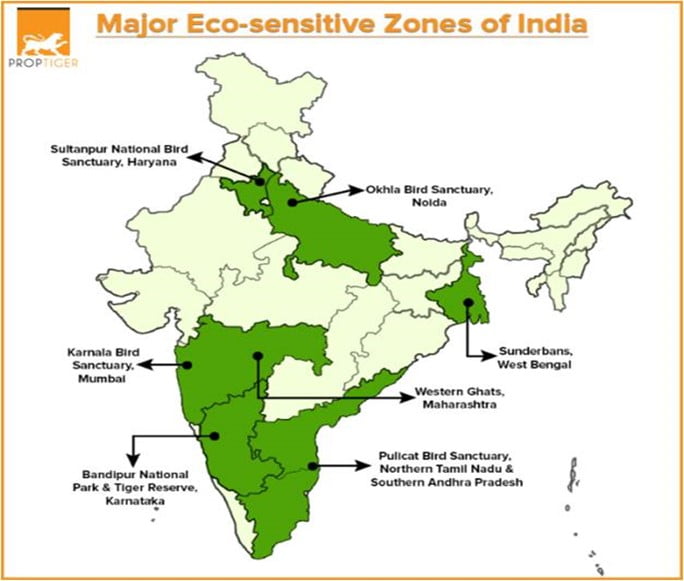Environment & Ecology
In News: On June 3, a three-judge bench of the Supreme Court heard a PIL which sought to protect forest lands in the Nilgiris in Tamil Nadu, but was later expanded to cover the entire country.
Context:
- The apex court directed all states to have a mandatory 1-km ESZ from the demarcated boundaries of every protected forest land, national park and wildlife sanctuary.
- It also stated that no new permanent structure or mining will be permitted within the ESZ.
- Protests erupted across the high ranges of Kerala in response to the apex court’s direction, similar to protests triggered by the recommendations of the Western Ghats Ecology Expert Panel (WGEEP) led by Madhav Gadgil
What are Eco-sensitive zones (ESZs):
- As per the National Wildlife Action Plan (2002-2016), issued by the Union Ministry of Environment, Forest and Climate Change, land within 10 km of the boundaries of national parks and wildlife sanctuaries is to be notified as eco-fragile zones or Eco-Sensitive Zones (ESZ).
- Areas beyond 10-km can also be notified by the Union government as ESZs, if they hold larger ecologically important “sensitive corridors.”
- They are created as “shock absorbers” for the protected areas, to minimize the negative impact on the “fragile ecosystems” by certain human activities taking place nearby.
- Furthermore, these areas are meant to act as a transition zone from areas requiring higher protection to those requiring lesser protection.
- ESZs are not meant to hamper the daily activities of people living in the vicinity, but are meant to guard the protected areas and “refine the environment around them”.
- Activities prohibited are commercial mining, saw mills, commercial use of wood, etc., apart from regulated activities like felling of trees.
- Permitted activities include ongoing agricultural or horticultural practices, rainwater harvesting, organic farming, among others.

- Various sections of society in the hill district have participated in public meetings, rallies, and door-to-door campaigns against the buffer zone regime.
Kerala State Remote Sensing and Environment Centre report:
- In its order, the apex court had directed the Principal Chief Conservator of Forests of each State and Union Territory (UTs) to draw up a list of subsisting structures and other relevant details within the respective ESZs and furnish a report.
- The court also warned that in the event of any State/UT failing to submit a proposal, an area of 10 kilometre would be considered as buffer zone in respect of such sanctuaries or national parks and restrictions would be imposed in those areas.
- Findings:
- The KSRSEC had also reported that 115 villages in Kerala would come under the buffer zone of the protected areas of the State.
- a total area of 1,588.709 sq. km would come under ESZs.
- The sanctuaries and national parks in the State are spread over an area of 3,441.207 sq. km.
- The assessment found that 83 tribal settlements were located within the ESZs of the State.
Challenges:
- Due to the high density of human population near the notified protected areas, farmer’s groups and political parties have been demanding that all human settlements be exempt from the ESZ ruling.
- Fearful farmers – the settler-farmers living around protected areas have become fearful that ESZ delineation would make farming impossible and they could be gradually evicted from their holdings.
- The ESZ demarcation move became an emotive issue for hundreds of farmers in the region who have successfully built their lives and settlements on forest fringes, battling inclement weather and wild beasts.
- Faulty KSRSEC report including allegations that the motive behind the survey was to relocate people from the forest fringes and thus expand forest cover in the State.
- The thick and dense canopy restricts the identification of all the subsisting structures and roads in the visual interpretation process.
- The price of land has plummeted following the release of the aerial survey report.
- Landowners worry that this will affect their plans based on the asset value of their holdings.
- This may affect the educational aspirations of students from rural areas
- Farmers are already burdened with fighting wild animal attacks and decreasing prices of agricultural produce
Suggestions:
- Conducting a scientific study along the lines prescribed by the Supreme Court to identify the subsisting structures.
- Using cadastral maps and the present land use/land cover pattern of the boundary sharing villages from satellite data on the GIS platform
- Kerala proposed to exclude human habitations and settlements from the ambit of the buffer zone.
- Using aerial survey report to highlight the density of the population and the presence of human habitations in the zone to take advantage of the apex court’s suggestion that an ESZ may be diluted in overwhelming public interest.
- The apex court had suggested that the minimum width of the ESZ may be diluted in the public interest and State governments should be able to convince the Central Empowered Committee(CEC) and the Ministry of Environment on the same.
- Setting up help desks in the panchayats of the State that come under the ESZ regime for physical verification of the holdings and settlements that come under the zone.
- The Kerala government appointed an expert committee headed by a former Chief Justice of the Calcutta High Court, for field verification.
Way forward:
- Kerela is a State sandwiched between the mountains and the sea, hence its ecological sustainability is a delicate subject
- Social changes due to modern environmental discourse in the form of tourism are disturbing the local ecological and social realities, in which the locals play an active role.
- There is a need for rethinking on the impacts of the environmental policies at the local level, the type and prospects of local participation and most importantly the prospects of alternate income generating opportunities for successful conservation initiatives.
Source The Hindu
Previous Year Question
Q.1) With reference to Eco-Sensitive Zones’, which of the following statements is/are correct? (2014)
- Eco-Sensitive Zones are the areas that are declared under the Wildlife (Protection) Act, 1972.
- The purpose of the declaration of Eco-Sensitive Zones is to prohibit all kinds of human activities in those zones except agriculture.
Select the correct answer using the code given below.
- 1 only
- 2 only
- Both 1 and 2
- Neither 1 nor 2













